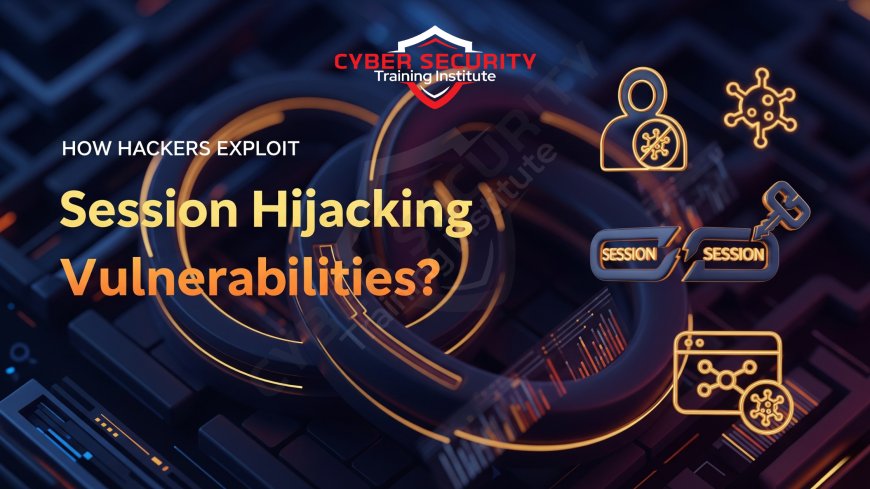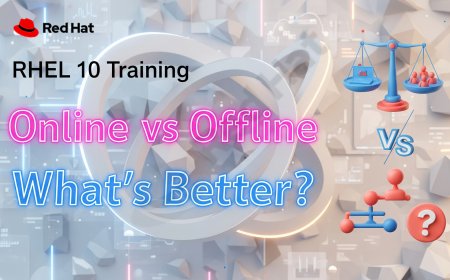How Hackers Exploit Session Hijacking Vulnerabilities
Session hijacking is a powerful and stealthy attack that allows a hacker to bypass the login process entirely and take over a user's live, authenticated session. This in-depth article explains how these critical vulnerabilities are exploited by modern cybercriminals. We break down the fundamental concept of the web session and the "session cookie" that acts as a user's temporary pass. Discover the primary techniques that hackers use to steal these session tokens, from classic "session sniffing" on insecure networks and Cross-Site Scripting (XSS) attacks, to the modern, MFA-bypassing Adversary-in-the-Middle (AitM) phishing campaign. The piece features a comparative analysis of the different types of session hijacking attacks and the primary defenses required to counter each one. We explain why the theft of a session cookie is the new primary goal for sophisticated attackers, as it allows them to defeat most common forms of multi-factor authentication. This is an essential read for any developer, security professional, or web user who wants to understand this persistent threat and the layered security model—from universal HTTPS to phishing-resistant authentication—that is required to defend against it.

Introduction: The Digital Ghost in the Session
You've carefully logged into your online bank account, using your complex password and your Multi-Factor Authentication code. You're in, and you feel secure. But what if a hacker could become a digital ghost, slip invisibly into your live, authenticated session, and take complete control without you ever knowing? This is the insidious danger of session hijacking. It's a powerful and popular type of cyberattack that bypasses the login process entirely. The attacker's goal is not to steal your password for later use; it is to steal your *active session* right now. Hackers exploit session hijacking vulnerabilities to impersonate a legitimate user and take full control of their authenticated session, making it a critical threat to modern web application security.
Understanding the "Session": Your Digital Wristband
To understand how session hijacking works, you first have to understand the concept of a "session." The protocol that powers the web (HTTP) is fundamentally "stateless." This means that every time your browser makes a request to a website (for example, by clicking a link), the website's server has no memory of who you are or what you did before. It's like talking to someone with no short-term memory.
To solve this, web applications use sessions. When you successfully log in, the server gives your browser a unique, temporary ID card. This is called a "session identifier" or, more commonly, a "session cookie." It's like getting a wristband at a concert. For every subsequent request you make, your browser automatically shows this "wristband" to the server, proving that you are the same person who just logged in. The server sees the valid wristband and lets you access the protected pages.
The vulnerability is simple but profound: if a hacker can steal this session cookie, they can present that same wristband to the server from their own computer. The server, seeing a valid wristband, will believe the hacker is you and give them full, authenticated access to your account.
Attack Technique 1: Session Sniffing on Insecure Networks
This is the classic eavesdropping attack and the simplest form of session hijacking. It relies on the victim being connected to an insecure network, most commonly a public Wi-Fi network like those found in cafes, airports, or hotels.
In this attack, the hacker connects to the same public Wi-Fi network as the victim. They then use a "packet sniffing" tool to listen to all the network traffic that is flowing through the air. If the victim then logs into a website that is not properly using HTTPS encryption, their session cookie will be sent in plain, unencrypted text. The attacker can simply "read" this cookie out of the network traffic, copy it, and then use it to take over the victim's session. This is why using public Wi-Fi is so risky and why it is absolutely critical that websites use HTTPS to encrypt all traffic, which makes this type of sniffing attack impossible.
Attack Technique 2: Cross-Site Scripting (XSS)
A far more common and sophisticated method for stealing session cookies is by exploiting a Cross-Site Scripting (XSS) vulnerability on a legitimate website. An XSS vulnerability is a flaw that allows an attacker to inject their own, malicious JavaScript code into a webpage that is then viewed by other users.
The attack works like this:
- The attacker finds a vulnerable part of a website, such as a comment section or a user forum, where they can post their malicious script.
- A legitimate, logged-in user then visits that compromised page.
- The malicious script, which is now part of the trusted webpage, automatically runs in the victim's browser. The script's job is simple: steal the user's current session cookie for that website and send it to a server controlled by the attacker.
The attacker now has the user's valid session cookie and can take over their account. This is an extremely dangerous attack because it happens on the real, trusted website, making it very difficult for the user to detect. .
Attack Technique 3: The Adversary-in-the-Middle (AitM) Phishing Attack
This is the current, state-of-the-art method for session hijacking and the primary way that attackers bypass Multi-Factor Authentication (MFA). In an AitM attack, the attacker uses a reverse proxy to create a perfect, real-time mirror of a legitimate login page. They then trick the user into logging in through this proxy.
The primary goal of a modern AitM attack is not just to steal the password or the one-time code; it is to steal the valuable session cookie that is generated *after* the successful login. The attacker's proxy sits in the middle of the entire login process, and when the legitimate website finally hands the user's browser the session cookie "wristband," the attacker's proxy simply intercepts it and steals it. This is the most dangerous form of session hijacking because it can defeat most common forms of MFA, as it is stealing the *result* of the successful authentication, not the credentials themselves.
Comparative Analysis: Types of Session Hijacking Attacks
While the goal is always the same—to steal a valid session token—the methods attackers use can vary widely, requiring different defensive strategies.
| Attack Type | How it Works | Primary Defense |
|---|---|---|
| Session Sniffing | An attacker on the same network eavesdrops on unencrypted Wi-Fi traffic to read the session cookie in plain text. | Universal HTTPS encryption (TLS/SSL) on the website, and avoiding the use of untrusted public Wi-Fi networks. |
| Cross-Site Scripting (XSS) | An attacker injects malicious JavaScript code into a vulnerable page on a legitimate website, which then steals the cookie from the victim's browser. | Secure coding practices by the website's developers, such as input sanitization and setting the HttpOnly flag on cookies. |
| Adversary-in-the-Middle (AitM) | An attacker uses a real-time proxy phishing site to intercept the entire login process and steal the final session cookie after a successful MFA login. | Phishing-resistant authentication (like Passkeys/FIDO2) which are immune to this, and strong user education to spot phishing lures. |
| Malware / Trojans | Malware running on the victim's computer steals the cookie file directly from the browser's local storage folder. | Modern endpoint security (like EDR and antivirus) and practicing safe browsing habits to avoid getting infected with malware. |
Conclusion: A Layered Defense for a Persistent Threat
Session hijacking is a critical and persistent threat because it allows an attacker to completely bypass the "front door" of the authentication process and teleport directly inside a user's authenticated session. It exploits the fundamental mechanism—the session cookie—that the web relies on to function. Defending against this threat requires a comprehensive, layered security strategy.
For website operators, it means a commitment to secure application development to prevent XSS and the universal enforcement of HTTPS encryption. For users, it means being vigilant against phishing attempts and practicing good cyber hygiene. But the ultimate solution is the evolution of our authentication models. The rise of sophisticated, MFA-bypassing session hijacking attacks is a clear sign that we need to move towards a new model of continuous authentication, where a user's identity is constantly being verified based on their behavior throughout a session, making a single stolen session cookie much less powerful.
Frequently Asked Questions
What is a session?
In web terms, a session is the period of interaction between a user's browser and a website. It starts when you log in and ends when you log out or the session expires.
What is a cookie?
A cookie is a small piece of data that a website stores in your web browser. A "session cookie" is a specific type of cookie that contains a unique ID to keep you logged in to a website during your session.
What is session hijacking?
Session hijacking, sometimes called cookie hijacking, is an attack where a criminal steals a legitimate user's active session cookie and uses it to impersonate that user on a website, gaining full access to their account.
What is Cross-Site Scripting (XSS)?
XSS is a type of web security vulnerability that allows an attacker to inject their own, malicious script into a webpage that is then viewed by other users. It is a very common method for stealing session cookies.
Why is public Wi-Fi risky?
Because on an open, unencrypted Wi-Fi network, it is possible for a nearby attacker to "sniff" or eavesdrop on your internet traffic. If you are visiting a site that does not use HTTPS, they can steal any data you send, including session cookies.
What is an Adversary-in-the-Middle (AitM) attack?
An AitM is a sophisticated phishing attack where a hacker's server acts as a real-time proxy between you and the real website, allowing them to intercept all your data, including your password, MFA codes, and session cookie.
How does HTTPS help prevent session hijacking?
HTTPS encrypts all the traffic between your browser and the website's server. This makes "session sniffing" impossible, as an attacker on the same network can see the encrypted traffic, but they cannot read the session cookie inside it.
What is continuous authentication?
Continuous authentication is an advanced security model where a user's identity is constantly and passively being verified throughout their entire session, often by using behavioral biometrics. This can detect if a session has been hijacked.
How can I protect myself from session hijacking?
Practice good security hygiene. Be extremely wary of phishing links, avoid using untrusted public Wi-Fi for sensitive activities, keep your browser and security software updated, and use phishing-resistant authentication like Passkeys wherever possible.
What is the "HttpOnly" cookie flag?
This is a security setting that a website developer can apply to a cookie. It tells the browser that the cookie should not be accessible to client-side scripts, which is a key defense against having it stolen via an XSS attack.
Is session hijacking the same as session fixation?
They are related but different. In session hijacking, the attacker steals the victim's existing session ID. In session fixation, the attacker tricks the victim into using a session ID that the attacker already knows *before* the victim logs in.
Can MFA stop session hijacking?
MFA is a powerful defense at the login screen, but a successful AitM attack can bypass it by stealing the session cookie *after* the MFA is complete. This is why session hijacking is such a dangerous threat in the MFA era.
What is a "packet sniffer"?
A packet sniffer is a piece of software or hardware that can intercept and log the traffic that is passing over a digital network. It's a key tool used for session sniffing.
Does this affect mobile apps?
Yes. Mobile apps also use session tokens to communicate with their backend servers via APIs. These tokens can also be stolen if the app has a vulnerability or if the communication is not properly encrypted.
What is a "reverse proxy"?
A reverse proxy is a server that sits in front of other servers and forwards client requests to those servers. In an AitM attack, the attacker's server is a malicious reverse proxy.
What is a browser's "cookie jar"?
This is a common, informal term for the local storage file in a web browser where all of the cookies are kept. Malware on a computer will often try to steal this file to get all of a user's saved session cookies.
What are Passkeys?
Passkeys are a modern, phishing-resistant replacement for passwords that are based on the FIDO2 standard. They are not vulnerable to the session hijacking that occurs via AitM phishing.
How do I know if my session has been hijacked?
It is very difficult to tell in real-time. A potential sign might be if you are suddenly logged out of a service for no reason, or if you see activity in your account that you do not recognize.
Is logging out of websites important?
Yes. When you log out, the server invalidates your session cookie, making it useless. For sensitive sites like your bank, it is a good security practice to always explicitly log out when you are finished, rather than just closing the browser tab.
What is the number one cause of session hijacking?
While there are multiple methods, the two most common and effective vectors are exploiting Cross-Site Scripting (XSS) vulnerabilities on the website itself, and tricking the user with a sophisticated Adversary-in-the-Middle (AitM) phishing attack.
What's Your Reaction?
 Like
0
Like
0
 Dislike
0
Dislike
0
 Love
1
Love
1
 Funny
0
Funny
0
 Angry
0
Angry
0
 Sad
0
Sad
0
 Wow
0
Wow
0

















